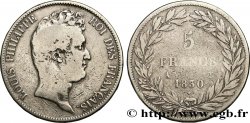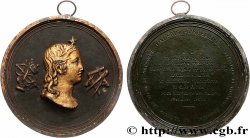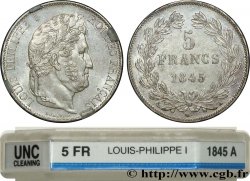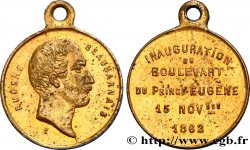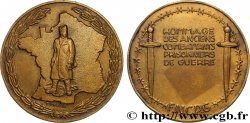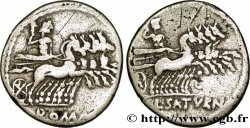E-auction 476-388096 - fme_740535 - LUDWIG PHILIPP I Médaille, Retour des cendres - funérailles de l’Empereur, refrappe
Sie müssen angeschlossen sein und von cgb.fr genehmigt werden, um in einer E-Auktion teilzunehmen.Melden Sie sich an, um zu wetten..Die Kontobestätigungen sind innerhalb von 48 Stunden nach Ihrer Anmeldung gemacht.Warten Sie nicht bis die letzten zwei Tage vor dem Abschluss eines Verkaufs, um Ihre Registrierung abzuschließen. Klickend "BIETEN" verpflichten Sie sich vertraglich, diesen Artikel zu kaufen und Sie nehmen ohne Reserve die allgemeinen Verkaufsbedingungen für den e-auctions zu cgb.fr an.
Der Verkauf wird an der Zeit auf der Übersichtsseite angezeigt geschlossen werden. Angebote, die nach der Schließung Zeit empfangen sind, werden nicht gültig.
Bitte beachten Sie, dass die Fristen für die Einreichung Ihres Angebots auf unsere Server können variieren und es kann zur Ablehnung Ihres Angebots entstehen, wenn es in den letzten Sekunden des Verkaufs gesendet wird. Die Angebote sollen mit ganzer Zahl ausgeführt sein, Sie können Kommas oder des Punktes in Ihrem Angebot nicht erfassen. Bei Fragen klicken Sie hier, um einen Blick auf die FAQ E-Auktionen.
KEINE ANSCHAFFUNGSKOSTEN FÜR DIE KÄUFER.
KEINE ANSCHAFFUNGSKOSTEN FÜR DIE KÄUFER.
| Schätzung : | 75 € |
| Preis : | 31 € |
| Höchstgebot : | 47 € |
| Verkaufsende : | 30 Mai 2022 18:10:30 |
| Bieter : | 5 Bieter |
Type : Médaille, Retour des cendres - funérailles de l’Empereur, refrappe
Datum: n.d.
Name der Münzstätte / Stadt : Monnaie de Paris
Metall : Bronze
Durchmesser : 58,5 mm
Stempelstellung : 12 h.
Graveur MONTAGNY Jean-Pierre (1789-1862)
Gewicht : 97,15 g.
Rand lisse + corne BRONZE
Punze : corne BRONZE
Kommentare zum Erhaltungszustand:
Aspect nettoyé, des frottements visibles à l’avers. Faible usure
Vorderseite
Titulatur der Vorderseite NAPOLÉON - EMPEREUR.
Beschreibung Vorderseite Tête laurée de Napoléon Ier à gauche. Signé : MONTAGNY F..
Rückseite
Titulatur der Rückseite FUNÉRAILLES DE L’EMPEREUR / 15 D.BRE 1840..
Beschreibung Rückseite Vue du cortège funèbre, avec l’Arc de Triomphe en arrière plan. Signé : MONTAGNY F..
Kommentare
Une refrappe moderne de la même facture présente un millésime sur la tranche (1967), ce qui n’est pas le cas de celui-ci.
En 1840, le président du Conseil Adolphe Thiers négocie avec le gouvernement anglais le retour des cendres de Napoléon 1er à Paris. Il veut, par cette initiative, redresser le prestige du roi Louis-Philippe 1er. Les Anglais acceptent le transfert, désireux qu'ils sont de se concilier la France avec laquelle ils sont en conflit sur la question d'Orient.
Le 15 décembre 1840, au cours d'une cérémonie populaire et grandiose, le char funèbre entre à Paris et se dirige vers les Invalides où il est accueilli par le roi en personne. Le sarcophage est exposé dans une chapelle du Dôme des Invalides en attendant son transfert dans la crypte monumentale, en 1861.
Sur le trajet, un million de Parisiens devenus bonapartistes pour l'occasion n'hésitent pas à crier « Vive l'Empereur ! ».
Le principal bénéficiaire de l'opération est le courant bonapartiste. Il reprend vie et il ne lui faudra que huit ans pour amener au pouvoir Louis-Napoléon Bonaparte, neveu du regretté empereur.
Napoléon 1er repose depuis lors en l'église Saint-Louis-des-Invalides, selon le voeu qu'il avait exprimé sur son île : « Je désire que mes cendres reposent sur les bords de la Seine, au milieu de ce peuple français que j'ai tant aimé » (Mémorial de Sainte-Hélène).
A modern re-striking of the same type has a year on the edge (1967), which is not the case with this one..
In 1840, the President of the Council, Adolphe Thiers, negotiated with the English government the return of Napoleon I's ashes to Paris.. With this initiative, he wants to restore the prestige of King Louis-Philippe I.. The English accepted the transfer, eager as they were to reconcile France with which they were in conflict over the Eastern question..
On December 15, 1840, during a popular and grandiose ceremony, the funeral carriage entered Paris and headed towards the Invalides where it was welcomed by the king himself.. The sarcophagus is displayed in a chapel of the Dôme des Invalides while awaiting its transfer to the monumental crypt in 1861..
Along the way, a million Parisians who had become Bonapartists for the occasion did not hesitate to shout \\\"Long live the Emperor!\\\".
The main beneficiary of the operation is the Bonapartist movement. He came back to life and it took him only eight years to bring Louis-Napoléon Bonaparte, nephew of the late emperor, to power..
Napoleon I has since rested in the church of Saint-Louis-des-Invalides, according to the wish he expressed on his island: \\\"I wish my ashes to rest on the banks of the Seine, among the French people whom I loved so much\\\" (Saint Helena Memorial)
En 1840, le président du Conseil Adolphe Thiers négocie avec le gouvernement anglais le retour des cendres de Napoléon 1er à Paris. Il veut, par cette initiative, redresser le prestige du roi Louis-Philippe 1er. Les Anglais acceptent le transfert, désireux qu'ils sont de se concilier la France avec laquelle ils sont en conflit sur la question d'Orient.
Le 15 décembre 1840, au cours d'une cérémonie populaire et grandiose, le char funèbre entre à Paris et se dirige vers les Invalides où il est accueilli par le roi en personne. Le sarcophage est exposé dans une chapelle du Dôme des Invalides en attendant son transfert dans la crypte monumentale, en 1861.
Sur le trajet, un million de Parisiens devenus bonapartistes pour l'occasion n'hésitent pas à crier « Vive l'Empereur ! ».
Le principal bénéficiaire de l'opération est le courant bonapartiste. Il reprend vie et il ne lui faudra que huit ans pour amener au pouvoir Louis-Napoléon Bonaparte, neveu du regretté empereur.
Napoléon 1er repose depuis lors en l'église Saint-Louis-des-Invalides, selon le voeu qu'il avait exprimé sur son île : « Je désire que mes cendres reposent sur les bords de la Seine, au milieu de ce peuple français que j'ai tant aimé » (Mémorial de Sainte-Hélène).
A modern re-striking of the same type has a year on the edge (1967), which is not the case with this one..
In 1840, the President of the Council, Adolphe Thiers, negotiated with the English government the return of Napoleon I's ashes to Paris.. With this initiative, he wants to restore the prestige of King Louis-Philippe I.. The English accepted the transfer, eager as they were to reconcile France with which they were in conflict over the Eastern question..
On December 15, 1840, during a popular and grandiose ceremony, the funeral carriage entered Paris and headed towards the Invalides where it was welcomed by the king himself.. The sarcophagus is displayed in a chapel of the Dôme des Invalides while awaiting its transfer to the monumental crypt in 1861..
Along the way, a million Parisians who had become Bonapartists for the occasion did not hesitate to shout \\\"Long live the Emperor!\\\".
The main beneficiary of the operation is the Bonapartist movement. He came back to life and it took him only eight years to bring Louis-Napoléon Bonaparte, nephew of the late emperor, to power..
Napoleon I has since rested in the church of Saint-Louis-des-Invalides, according to the wish he expressed on his island: \\\"I wish my ashes to rest on the banks of the Seine, among the French people whom I loved so much\\\" (Saint Helena Memorial)








 Berichten über einen Fehler
Berichten über einen Fehler Die Seite drucken
Die Seite drucken Teilen meiner Auswahl
Teilen meiner Auswahl Stellen Sie eine Frage
Stellen Sie eine Frage Einlieferung/Verkauf
Einlieferung/Verkauf
 Details
Details